I've been out of the headphone game for some time now, focusing on my 2-channel speaker setup rather than headphones for the last two years. The last headphones I bought were a pair of ESW9 for $80 four months ago (audio-technica warehouse sale ftw). Though I have been slowly but surely making my way back to headphone listening. I was browsing ebay and came across an auction with 5 minutes left for the K270 Studio dual-driver headphone. I was interested in owning a pair because of their rare design and for the sake of furthering my own headphone collection. I honestly didn't expect much in terms of their sonic capability, given the reviews for them are so polarizing. I decided to buy them, waiting until the last 20 seconds to place the winning bid for $65. 
When I plugged them in and listened for the first time, I was pleasantly surprised. More full and musical than I was expecting. However, as the headphones warmed up from being on my doorstep all day, they started to really, really shock me. I started to become immersed in my music in ways I haven't experienced since I got into hifi equipment. I guess their sound signature just works for me. On the warm side, yet somehow detailed in its own way. The highs are a bit rolled-off, so if you are into hyper-detailed treble extension these aren't for you. However, this is where the weakness ends. The mids and bass response on these are among the best I've heard on headphones. Three days later and I still have the same impression.
Vocals sound warm, natural and placed right where they should be. Very representative of the recording. I am beginning to see what the famous "akg mids" are all about. The soundstage is large, as most people have stated. However soundstage isn't exaggerated unlike some headphones (k702 for me). It just seems accurate. Attack and speed are quite good, spreading the work between two separate transducers.
Bass frequencies are the most amazing part. These extend lower than any headphone I own, and seemingly without attenuation. Yet these are not "bassy" headphones by any means. They just have the ability to play back exactly what's in the recording. This makes me realize that many of my other headphones are clearly rolled-off in the low-end in favor of more forward mids and treble. Listening to large orchestras where double bass and bass drum are prevalent results in a skull-rattling experience. This may sound unpleasant, but it's definitely not. It's what you would actually feel listening to a live orchestra. Hearing the low-frequency echoes and vibrations of the venue is an incredible experience. On the flip-side, if a recording is not bass-heavy, these headphones will represent that fact. They will sound tight, agile and controlled.
The result is a (nearly) full spectrum of sound with extremely good separation and little distortion. Probably one of the reasons that I get so immersed in the music with these. Being able to hear every single instrument individually is part of what we audiophiles crave, and these truly offer it.
That's about it, just wanted to share my excitement and opinions on this headphone. Probably the best money I've ever spent on a piece of audio gear.
Nate

When I plugged them in and listened for the first time, I was pleasantly surprised. More full and musical than I was expecting. However, as the headphones warmed up from being on my doorstep all day, they started to really, really shock me. I started to become immersed in my music in ways I haven't experienced since I got into hifi equipment. I guess their sound signature just works for me. On the warm side, yet somehow detailed in its own way. The highs are a bit rolled-off, so if you are into hyper-detailed treble extension these aren't for you. However, this is where the weakness ends. The mids and bass response on these are among the best I've heard on headphones. Three days later and I still have the same impression.
Vocals sound warm, natural and placed right where they should be. Very representative of the recording. I am beginning to see what the famous "akg mids" are all about. The soundstage is large, as most people have stated. However soundstage isn't exaggerated unlike some headphones (k702 for me). It just seems accurate. Attack and speed are quite good, spreading the work between two separate transducers.
Bass frequencies are the most amazing part. These extend lower than any headphone I own, and seemingly without attenuation. Yet these are not "bassy" headphones by any means. They just have the ability to play back exactly what's in the recording. This makes me realize that many of my other headphones are clearly rolled-off in the low-end in favor of more forward mids and treble. Listening to large orchestras where double bass and bass drum are prevalent results in a skull-rattling experience. This may sound unpleasant, but it's definitely not. It's what you would actually feel listening to a live orchestra. Hearing the low-frequency echoes and vibrations of the venue is an incredible experience. On the flip-side, if a recording is not bass-heavy, these headphones will represent that fact. They will sound tight, agile and controlled.
The result is a (nearly) full spectrum of sound with extremely good separation and little distortion. Probably one of the reasons that I get so immersed in the music with these. Being able to hear every single instrument individually is part of what we audiophiles crave, and these truly offer it.
That's about it, just wanted to share my excitement and opinions on this headphone. Probably the best money I've ever spent on a piece of audio gear.
Nate



